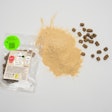
In the dynamic landscape of the pet food industry, various commercial pet food formats have arisen in response to consumer demands and attempts to optimize nutrition. The effects of processing conditions, particularly temperature and duration of heating, on pet food digestibility remains a critical area of exploration. In a recent study conducted to address this gap, University of Illinois Urbana-Champaign researchers conducted an experiment to determine the amino acid digestibilities and nitrogen-corrected true metabolizable energy values of different pet food formats. The scientists published their results in the Journal of Animal Science.
The study compared four distinct pet food formats: frozen raw, freeze-dried raw, fresh and extruded dog foods. Diets from reputable brands such as Hill’s Science Diet, Just Food for Dogs, Primal Pet Foods, and Stella & Chewy’s were subjected to precision-fed cecectomized and conventional rooster assays. The chosen diets were Chicken and Barley Recipe, Chicken and White Rice Recipe, Chicken Formula, Chicken and Sorghum Hybrid Freeze-dried Formula, and Chicken Dinner Patties.
Amino Acid Digestibilities
- Freeze-dried raw exhibited the highest, while extruded showed the lowest amino acid digestibilities.
- Lysine digestibility was notably higher in freeze-dried raw and frozen raw compared to extruded.
- Threonine digestibility was higher in freeze-dried raw than extruded.
Reactive Lysine:Total Lysine Ratios
- Ratios ranged from 0.93 to 0.96, with freeze-dried raw, frozen raw, and fresh diets maintaining a consistent high-quality profile.
True Metabolizable Energy
- Frozen raw demonstrated higher true metabolizable energy than freeze-dried raw, fresh, and extruded.
- HFD exhibited higher true metabolizable energy than fresh and extruded.
- Freeze-dried raw showed higher true metabolizable energy than extruded.
The study's findings underscore the significant impact of diet processing on amino acid digestibilities and true metabolizable energy values. Notably, freeze-dried raw, hybrid freeze-dried raw, frozen raw and fresh diets outperformed the extruded diet in terms of higher amino acid digestibility coefficients and greater true metabolizable energy values. However, the study acknowledges that other factors, such as ingredient inclusion and macronutrient composition, may also influence these results.
For professionals in the pet food industry, these findings emphasize the importance of considering processing conditions in formulating pet diets. While the study provides valuable insights, it also highlights the need for further research.
“More research in dogs is necessary to test the effects of format on diet palatability, digestibility, stool quality, and other physiologically relevant outcomes,” the study authors wrote.
Roosters help study of pet food protein digestibility
A surgical procedure, similar to a human appendectomy, turns roosters into an effective, efficient model for dogs’ and cats’ digestive systems, which helps with pet food nutrition research. The technique, called the precision-fed cecectomized rooster assay, allowed Kelly Swanson, PhD, University of Illinois – Urbana-Champaign animal nutrition professor, to compare the digestibility of chicken meal to raw, steamed and retorted chicken.
“We and others in the pet food industry not only analyze protein quality (amino acid profile) of ingredients, but use the cecectomized rooster assay to assess amino acid digestibility,” he said in a previous article. “Knowing both protein quality and digestibility are needed to accurately formulate diets and ensure that dogs/cats are meeting their needs.
“Although the current study only tested specific ingredients, one can use this assay to test complete diets that are processed in various ways,” he said. “If done in that manner, one could compare how extrusion compares to retort, pasteurization, freeze-drying, etc. It could also be used to test kibble diets formulated using chicken meal versus fresh chicken.”
Other methods of analyzing pet food protein and amino acid digestibility have drawbacks compared to the cecectomized rooster assay. For example, estimates of digestibility that use fecal analysis aren’t accurate because the bacteria and other microorganisms, or microbiota, in dogs’ and cats’ large intestines alter the results, Swanson said. Cat and dog microbiota eat some of the nutrients in the animals’ food too, masking the true digestibility of the pet food.
“In addition to avoiding the bias provided by large intestinal microbiota, the cecectomized rooster assay allows one to test individual ingredients,” he said. “This is not possible in dog or cat studies where complete diets must be fed, and the ingredient in question is only a proportion of the diet.”
Likewise, in vitro studies of nutrient digestibility can’t match the cecectomized rooster assay, Swanson said. In vitro lab experiments focus on specific ingredient categories, such as soy- or chicken-based proteins, so those procedures aren’t accurate for other ingredients. This makes it especially difficult to test novel pet food ingredients.
“Therefore, we believe that the cecectomized rooster assay is the best choice for testing the amino acid digestibility of novel protein sources or those undergoing different processing conditions,” he said.
Effects of cecectomized rooster assay on the birds
For decades, scientists have used the cececomtized rooster assay as a model of not only dog and cat digestion, but also that of humans and livestock. Although differences exist between mammals’ and birds’ anatomy and metabolism, biologists have found that the cececomtized rooster assay provides a good estimate for dogs, cats and other animals’ digestion.
The roosters themselves experience few health issues from the surgical removal of their two cecum, or ceca, said Swanson. Roosters need a brief recovery period before the studies begin, then the birds can be housed and cared for just like other roosters in animal research facilities.
“In regards to animal welfare, the rooster assay is a good example of the 3R’s of research: reduction, replacement and refinement,” said Swanson. “It replaces the need for work in dogs and cats, is a refined and accurate technique, and requires a small number of animals (four or five birds per ingredient tested) due to its accuracy.”



















